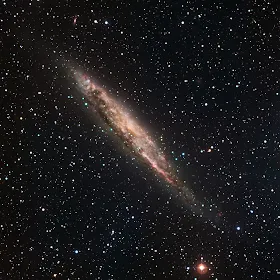This beautiful telephoto composition spans light-years in a natural night
skyscape from the island of Crete. Looking south, exposures both track the
stars and record a fixed foreground in three merged panels that cover a 10×12
degree wide field of view. The May 15 waxing gibbous moonlight illuminates the
church and mountainous terrain. A mere 18 thousand light-years away, huge
globular star cluster Omega Centauri (NGC 5139) shining above gives a good
visual impression of its appearance in binoculars on that starry night. Active
galaxy Centaurus A (NGC 5128) is near the top of the frame, some 11 million
light-years distant. Also found toward the expansive southern constellation
Centaurus and about the size of our own Milky Way is edge on spiral galaxy NGC
4945. About 13 million light-years distant it’s only a little farther along,
and just above the horizon at the right. Image Credit & Copyright: Johannes
Schedler (Panther Observatory)
Ο Κένταυρος Α
(ή NGC 5128) είναι ένας φακοειδής ενεργός γαλαξίας στον
αστερισμού του Κενταύρου και ένας από τους κοντινότερους στη Γη ραδιογαλαξίες.
Βρίσκεται σε απόσταση περίπου 11 εκατομμύρια έτη φωτός. Είναι ο πέμπτος
λαμπρότερος γαλαξίας στον ουρανό.
The globular
cluster Omega Centauri — with as many as ten million stars — is seen in all its
splendour in this image captured with the WFI camera from ESO's La Silla
Observatory. The image shows only the central part of the cluster — about the
size of the full moon on the sky (half a degree). North is up, East is to the
left. This colour image is a composite of B, V and I filtered images. Note that
because WFI is equipped with a mosaic detector, there are two small gaps in the
image which were filled with lower quality data from the Digitized Sky Survey. Credit ESO
Ο Ωμέγα
Κενταύρου (ή NGC 5139) είναι σφαιρωτό σμήνος, επίσης στον
αστερισμό του Κενταύρου, σε απόσταση 15.800 έτη φωτός από τη Γη. Είναι το
μεγαλύτερο σφαιρωτό σμήνος στον Γαλαξία, με διάμετρο περίπου 150 έτη
φωτός. Συνίσταται από 10 εκατομμύρια άστρα και έχει συνολική μάζα ίση
με 4 εκατομμύρια ηλιακές μάζες.
This photograph
shows a sky field around the spiral galaxy NGC 4945 . It is assembled from five
15-minute R(ed)-narrowband (shown in red), four 5-minute B(lue)-band (shown in
green), and five 1000-second U(ltraviolet)-band (shown in blue) exposures,
obtained in January 1999 during the Science Verification phase with the
Wide-Field-Imager (WFI) at the MPG/ESO 2.2-m telescope at La Silla. At the
recession velocity of NGC 4945, the red filter, centred at 665 nm with an FWHM
(full width at half maximum) of only 1.2 nm, does not include the H-alpha
emission line of interstellar hydrogen in this galaxy. The original resolution
of about 1 arcsec corresponds to roughly 62 light-years at the distance of NGC
4945 (13 million light-years). In addition to NGC 4945 itself, some much more
distant galaxies can be recognized as faint, slightly red light patches in the
field. The vast majority of the point-like sources are stars in the Milky Way.
However, a fair number of those near NGC 4945 are globular clusters belonging
to this galaxy. Each frame records 8184 x 8196 = 67,076,064 pixels, and thus
the total number of data points (pixels) of the 14 CCD frames used to make this
photo is almost 10 9. Their collective information content corresponds to more
than 70 x 10 9 photons (not counting those from the Earth's upper atmosphere
that were recorded simultaneously). The field covers 32 x 32 arcmin 2. East is
to the left and North to the top. Credit ESO
Κάτω
δεξιά διακρίνεται και ο σπειροειδής γαλαξίας NGC 4945 που ανακάλυψε
ο αστρονόμος James Dunlop το 1826.
Η
φωτογραφία λήφθηκε από τον Johannes Schedler στις 15 Μαΐου 2016 από μια ορεινή
περιοχή της ανατολικής Κρήτης. Αναγνωρίζει κανείς την περιοχή;



Δεν υπάρχουν σχόλια:
Δημοσίευση σχολίου